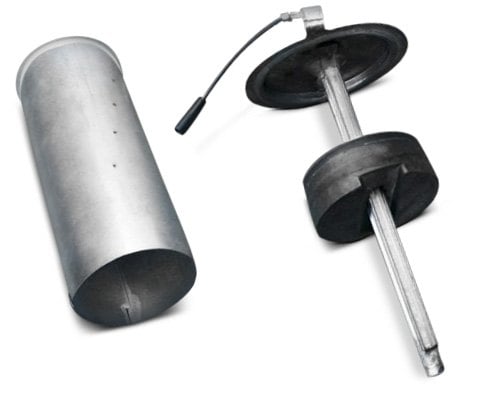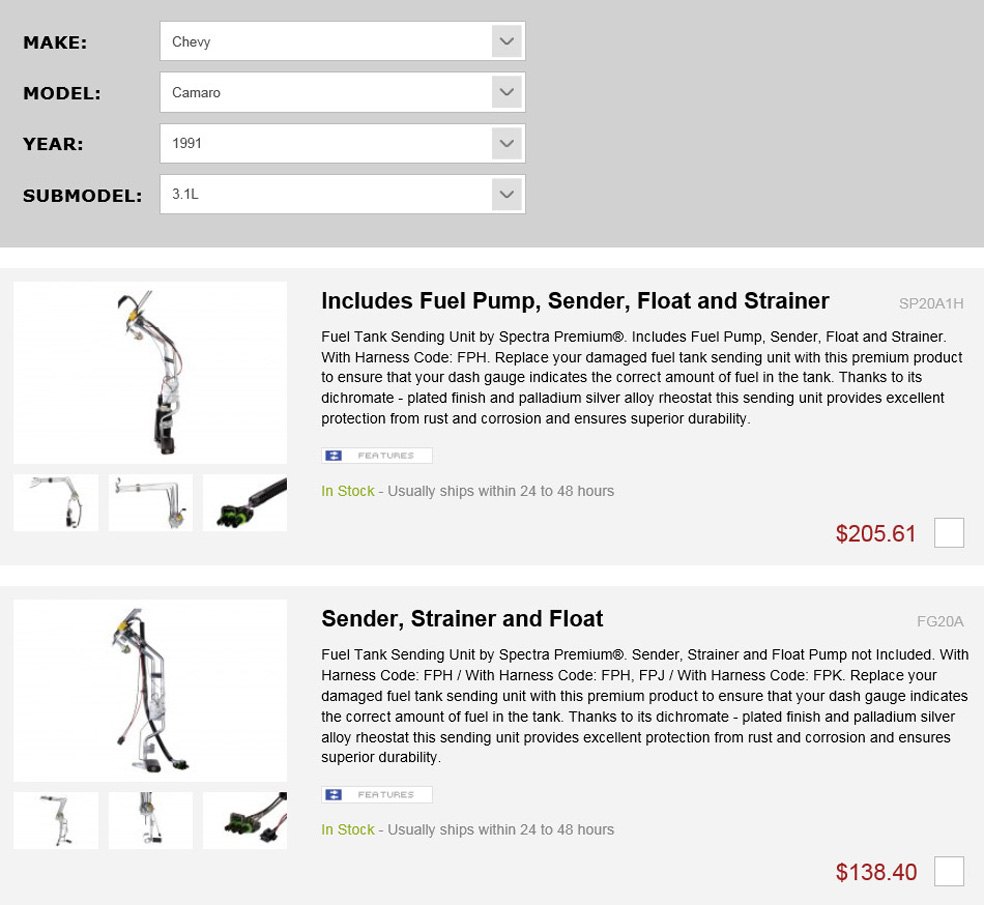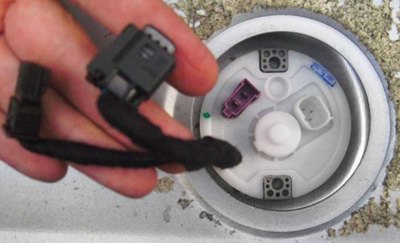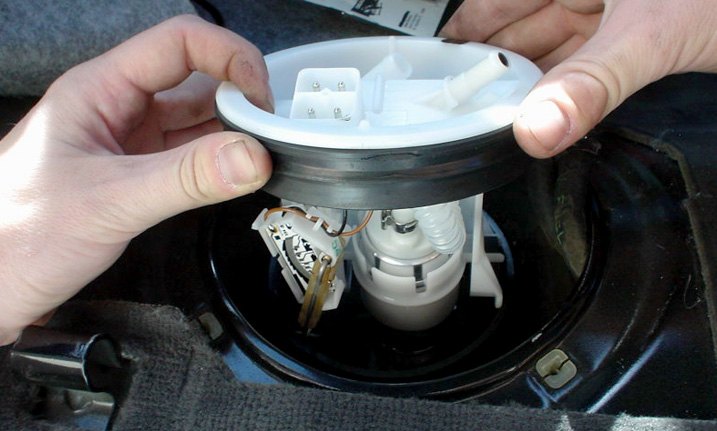Tools And Materials Needed:
- Replacement fuel tank sending unit
- Replacement lock ring and seal
- Flat head or Phillips head screwdriver
- Groove Joint Pliers
- Hammer
- Open-ended wrenches
- Rubber gloves (optional)
Definition And Description Of A Fuel Tank Sending Unit
A Fuel tank sending unit is a term for the mechanical assembly inside your fuel tank which measures the level of liquid in the tank, then reports its findings to the fuel gauge on your instrument cluster. All sending units contain a "float" piece which does just what it describes - floats atop the surface of the fuel. Many automakers design the float piece as an attachment on a hinged arm that pivots as the level in the tank rises or drops. Others design the float piece as a cylinder that rides up and down around a metal shaft.


The float's arm is attached to a variable resistor. As the float arm moves with changes in fuel level, the resistance changes. This changes the amount of current sent to the fuel gauge, which in turn changes the gauge's reading.
As often happens with automotive technical terms, this part may also be listed under different names. Depending on your vehicle, this part may also be called a "Fuel Pump Module Assembly" or a "Fuel Pump Hanger Assembly". This raises an important distinction: some "fuel tank sending units" are designed to include a fuel pump, while some are not. More about this under "ORDERING AND REPLACING".
Reasons To Replace Your Fuel Tank Sending Unit
Over time, the electrical components in fuel sending units can short out and produce no fuel level reading, or the mechanical components can deteriorate and produce a non-changing, fluctuating, or completely inaccurate reading. Fuel pumps can also fail. A complete pump failure will result in a non-running engine. However, the pump may slowly lose its ability to deliver the required fuel pressure. This can be caused by contaminants in the fuel, or just old age. A fuel pump delivering less fuel than needed will cause the driver to experience hesitation, bucking, or stalling.
Because the fuel sending unit assembly is mounted at the top of your fuel tank, it's relatively easy to replace on most modern vehicles equipped with purpose-built access ports. In this article, we'll cover the steps involved in replacing the fuel sending unit on vehicles where easy access is possible.
It can also be easy to remove the unit for inspection and testing. For example, to verify that an inaccurate fuel gauge is caused by a bad sending unit, some technicians will remove the unit from the gas tank and manually manipulate the float arm, watching for changes in the gas gauge. A visual inspection may also turn up other problems, such as a clogged filter, loose connections, or deteriorated hoses.
Ordering And Replacing Your Fuel Tank Sending Unit
As briefly mentioned above, some replacement units are available with the fuel pump assembly, and some without. You need to understand why the fuel tank sending unit is being replaced and order accordingly! Looking at the illustration below, the owner of this car has the option of purchasing the fuel pump. So if it's the sender which is defective, some expense can be saved. If, on the other hand, it's the fuel pump which is bad, the owner must be certain to select the option which includes the pump, and not just order the cheaper choice.

If you have a vehicle without a fuel tank access panel, the whole fuel tank will need to be unbolted and dropped down - a separate process we won't be covering in the scope of this article. Briefly, that job involves removal of all fuel from the tank, and on some vehicles, lowering of exhaust and/or suspension components. Once the fuel tank is out of the car, the steps involved with the actual sending unit removal and reinstallation are similar.
Steps Involved
NOTE! Be careful! You are working near gasoline. You must not smoke, have open flame, or create sparks. Always have a fire extinguisher nearby.
1. Because your fuel lines remain under pressure (very high pressure on some vehicles), it's important to relieve that pressure first. Check your owner's manual for the location of the vehicle's fuel pump relay, and remove the relay to deactivate the fuel pump. Turn the ignition key to crank the engine, which will start and stall several times once no fuel is being pumped to it. When the engine no longer catches even a little, the fuel lines you'll be disconnecting have been depressurized.



2. Disconnect the negative battery cable to ensure any possibility of sparks around gasoline is eliminated. NOTE! Some vehicles will have radio pre-sets erased when the battery is disconnected. It is a best practice to record the pre-sets so that the radio can be easily reprogrammed.
3. Open your fuel cap to relieve any built up pressure in the tank.
4. Consult a repair manual for your specific vehicle to locate the access port for the top of your fuel tank. On many vehicles, the top of your fuel tank can be accessed by opening a "trap door" that's located underneath the rear seat cushion or underneath carpeting on the trunk floor. The removable cover piece should be secured by screws or small bolts that require only basic hand tools to remove. Vehicles with rear seat access typically design the seat cushion so it's easy to pull out.


Once the access cover panel has been removed, you'll be looking directly down at the top of the fuel tank. You'll see what looks like a round lid - this is actually the top of the fuel sending unit assembly. On it, there are connecters for the wiring harness which run to your fuel gauge.
Unplug any connectors and move the wiring to the side. NOTE! If there is more than one connector, a best practice is to label the connectors to ensure correct reassembly. Disconnect and remove any fuel hoses which are attached to the sender, again labeling hoses if there is more than one.
5. Most fuel tank sending units are held in place with a lock ring, which is rotated counter-clockwise to loosen. While there are special tools designed to perform this job, you usually can accomplish the removal with a pair of groove-joint pliers, or a hammer and drift. In either case, be certain not to damage components. You won't need to twist it very far before it unlocks. The edge of the ring will have multiple notches for you to grab with the pliers or to put the drift against. A number of replacement sending units will include a new lock ring and seal. It is a best practice to always replace the seal under the lock ring. Some suppliers offer lock rings and seals separately.

6. Remove the old fuel sending unit by pulling the assembly up through the top. Because there's a long rod and float piece, angling it out may be necessary.
7. Install your new fuel sending unit by first placing the new tank seal in place. Lower the new unit into the tank, being certain that if there are any wires or hoses in the tank, the movable float arm remains clear of interference. Install the lock ring, and do not overtighten it. Reconnect the hoses and wiring connectors, and secure all covers in the reverse order they were removed.
8. Reinstall the fuel pump relay, and reconnect the battery. Start the car, checking that the fuel gauge works and that there are no fuel leaks. The next time you refill the tank, check to make sure that no fuel is seeping from the top of the tank where the sender is installed.

